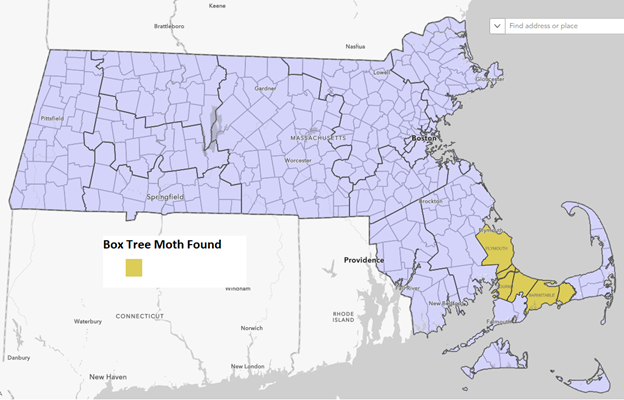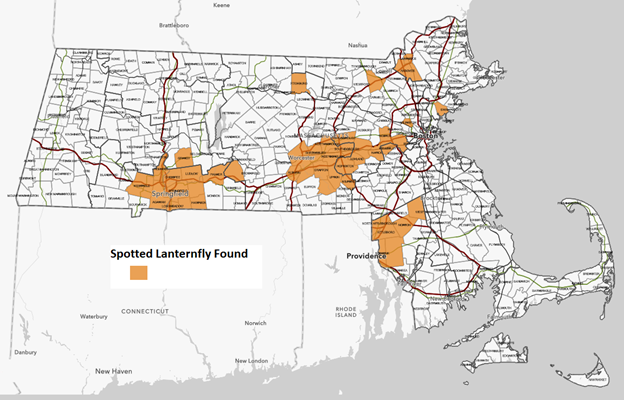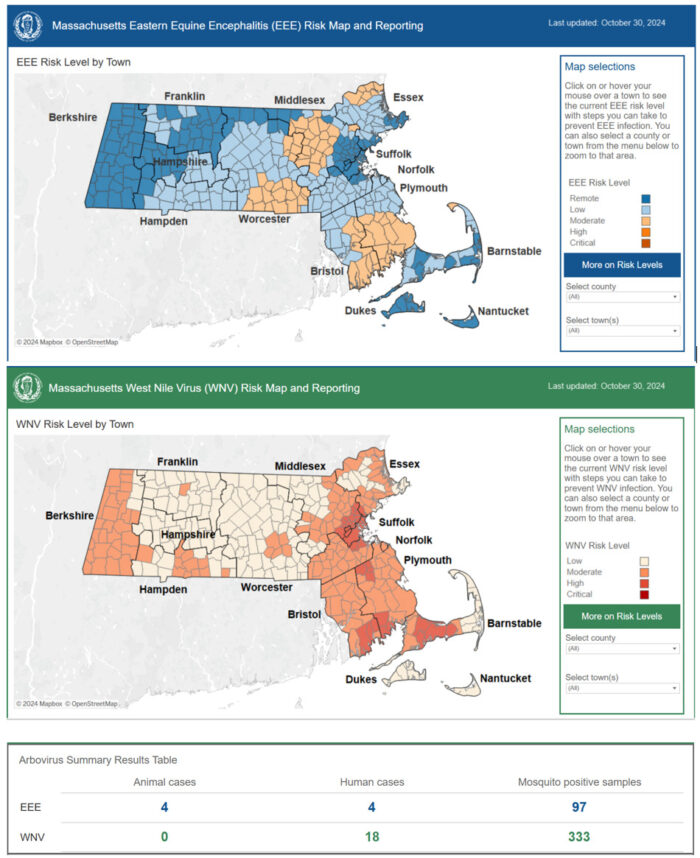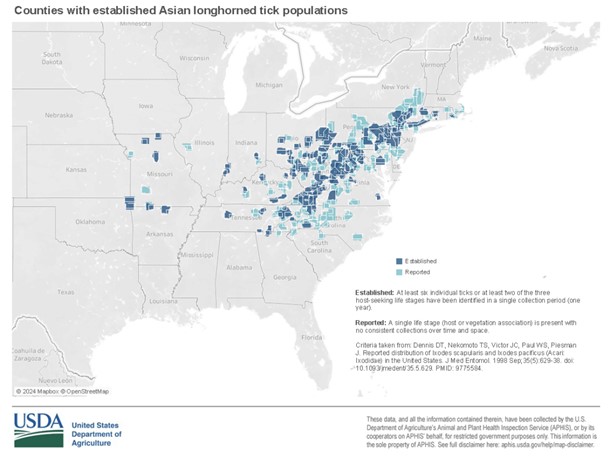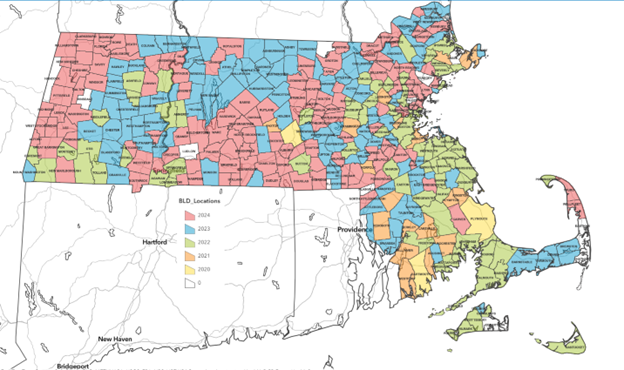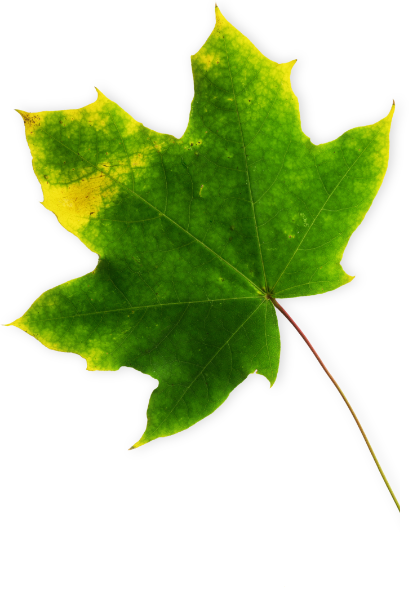 Weather
Weather
Rainfall in recent years has been quite erratic. We had a very wet spring this year a fairly average summer, and an incredibly dry fall. Last year we saw a fairly average spring, a very wet summer and another dry fall. Wet weather particularly in the spring is a driver for a foliar disease. Drought in the fall can lead to winter burn injury over the winter if evergreen plantings cannot maintain moisture in their leaves. Rainfall will never consistently supply enough water when we want it. By supplementing water in times of drought will help to reduce plant stress. The larger the plant the longer I can take for that plant to show signs of water stress. Small perennials you may see signs of drought stress in days. Trees may not show sigs of drought stress for years after the stress happened. This is primarily due to significantly larger biomass and energy reserves that are able to buffer changes in the environment. Because we can’t directly manage all the environmental stressors that affect plants it is even more important to manage other stressors that we can. Begin by planting trees and shrubs in the right place for their needs. Often times there are disease and pest-resistant varieties. For older plantings that are not as easily replaced, supplement water, when possible, treat for serious insects and diseases that can compound other stressors.
Insects
Box Tree Moth: The box tree moth (Cydalima perspectalis) has become a growing concern in Massachusetts and other parts of the United States since its first confirmed detection in North America in 2018. This invasive pest from Asia, poses a significant threat to boxwood plants (Buxus spp.), which are popular in the landscapes. The moth’s larvae feed on boxwood leaves causing defoliation. Several overlapping generations are expected to occur per year, with an estimated 1-5 generations possible from May to September. Green caterpillars with black-and-white stripes skeletonize leaves and form webbing on branches. Severe infestations may cause branches to brown and plants to die.
The Massachusetts Department of Agricultural Resources (MDAR) is actively monitoring the spread of the box tree moth and working to contain outbreaks. State agencies have been collaborating with homeowners, landscapers, and nursery owners to increase awareness and implement control measures. If you suspect a box tree moth infestation, report it to MDAR to help track and control its spread. https://massnrc.org/pests/report.aspx
To protect your boxwoods, monitor regularly for infestations. Small infestations may be controlled with selective pruning. As this pest continues to spread itself around regular spraying may become necessary to manage this pest. Boxwoods also regularly suffer from boxwood psyllid, boxwood leafminer, and spider mites, as well as diseases like boxwood blight, Volutella and leafspots and winter injury. Depending on the situation, replacement with alternative plants such as Japanese holly may be an option.
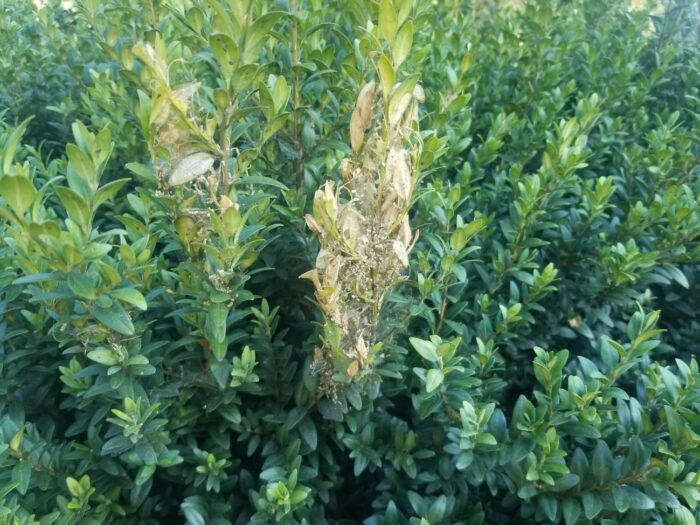
Damage caused by box tree moth caterpillar feeding viewed on plants in Barnstable County, MA in 2023. Photo courtesy of Russ Norton, Cape Cod Cooperative Extension.
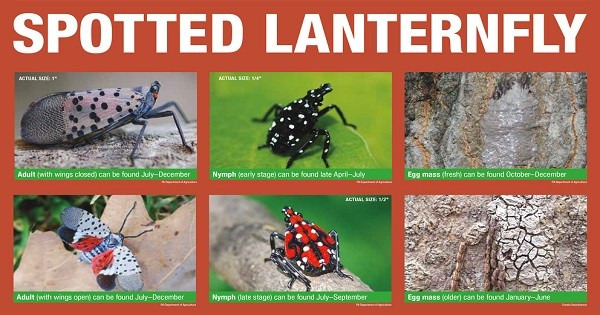 Spotted Lanternfly: Spotted lanternfly is another invasive species first found in Massachusetts in 2021. Some of the newest established populations have now been in the Seekonk and Attleboro area. There have been several other sightings of individuals throughout the state, but no established populations were found associated with them. Spotted lanternfly is particularly problematic for grapes and fruit trees because of the damage to fruit and productivity. In the landscape, however, they are more of a nuisance for a wide variety of shrubs and trees. The primary concern is the high numbers and density of insects and the mess they make by their feeding. As sucking insects, they will produce lots of honey dew (liquid insect poop) and black sooty mold that will then grow on the sugary excrement. Everyone should be on the lookout for this pest since continued spread is very likely. If any life stages of this insect are found in Massachusetts, it should be reported here: https://massnrc.org/pests/slfreport.aspx .
Spotted Lanternfly: Spotted lanternfly is another invasive species first found in Massachusetts in 2021. Some of the newest established populations have now been in the Seekonk and Attleboro area. There have been several other sightings of individuals throughout the state, but no established populations were found associated with them. Spotted lanternfly is particularly problematic for grapes and fruit trees because of the damage to fruit and productivity. In the landscape, however, they are more of a nuisance for a wide variety of shrubs and trees. The primary concern is the high numbers and density of insects and the mess they make by their feeding. As sucking insects, they will produce lots of honey dew (liquid insect poop) and black sooty mold that will then grow on the sugary excrement. Everyone should be on the lookout for this pest since continued spread is very likely. If any life stages of this insect are found in Massachusetts, it should be reported here: https://massnrc.org/pests/slfreport.aspx .
Pests
Mosquitoes: Mosquitoes have been very persistent this year with the frequency of rain maintaining plenty of breeding habitat. The instances of mosquito borne diseases actually saw a dramatic increase. This year there were 333 positive West Nile Virus mosquito samples collected and 18 human cases of WNV, about twice the numbers as last year. Eastern equine encephalitis nearly tripled this past year, 97 positive EEE mosquito samples collected with 4 human cases in the state. Both WNV and EEE are spread when mosquitos feed on infected birds that then bite people. Infected mosquitos also spread the viruses to other birds.
Mosquitos take about 2 weeks to develop. Eggs will hatch within 2 days, larvae a week or more and another couple of days to pupate. Mosquitoes lay their eggs in standing water. Limit the number of places around your home for mosquitoes to breed by draining or discarding items that hold water every couple of days and check rain gutters and drains. Aside from reducing breeding as much as possible, regular treatments can help to manage mosquito populations in your yard.
Ticks: There are several kinds of ticks to be on the lookout for in Massachusetts. Black legged ticks are the most common ticks and are the primary transmitter of Lyme disease. Dog ticks are somewhat larger and less common to bite people. Lone star ticks are more aggressive in seeking out hosts compared the questing most ticks do, waiting for a host to brush past. Lone star ticks are isolated to Cape Cod and the islands at this point. There is yet another new invasive tick species spreading called the Asian longhorned tick. Asian longhorned ticks have been primarily associated with livestock but can bite people and pets as well and do not need to mate to produce thousands of eggs.
The same precautions to avoid black legged ticks will help with these other species as well. Aside from regular yard treatments, repellents containing DEET, picaridin, and oil of lemon eucalyptus can be used for both ticks and mosquitoes directly on skin or permethrin can be used to treat clothes.
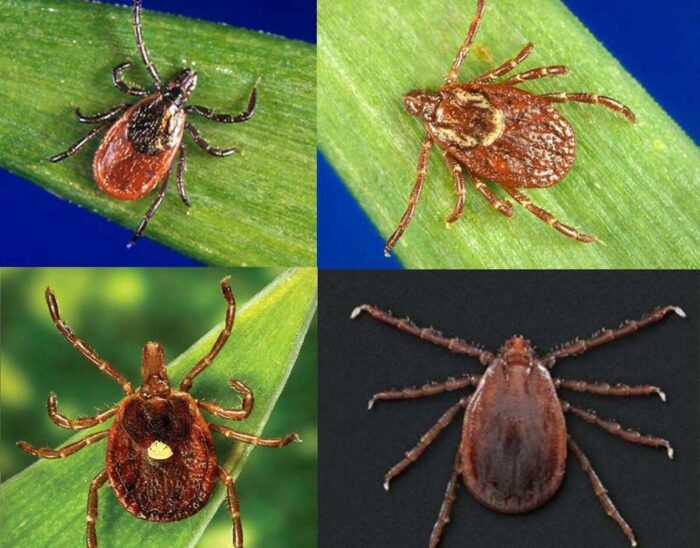
Top, from left: The blacklegged or deer tick and American dog tick; bottom, from left: lone star tick and Asian longhorned tick Smith Collection/Gado/Getty Images; CDC
The graphs below show that in October of 2024, less than 0.4% of visits to Emergency Departments (ED) in any week were related to exposure to ticks, while less than 0.1% of visits to EDs in any week were related to diagnosis of a tick-borne disease. The 2024 data are shown compared to both the minimum and the maximum number of visits recorded over the last three years. While tick activity usually increases in Spring and early Summer and then again in Fall, exact timing is dependent on weather.
Massachusetts Department of Public Health, Bureau of Infectious Disease and Laboratory Sciences. Tick Exposure and Tick-borne Disease Syndromic Surveillance Report, October 2024. http://www.mass.gov/eohhs/gov/departments/dph/programs/id/
This map shows the rate, per 10,000 total population, of ED visits by patients who had a visit related to a tick exposure, by Massachusetts county of residence, 2024 to date. Although there are differences in the rate of patient visits, this shows that people are exposed to ticks throughout all of Massachusetts and should take recommended steps to reduce the chance of being bitten.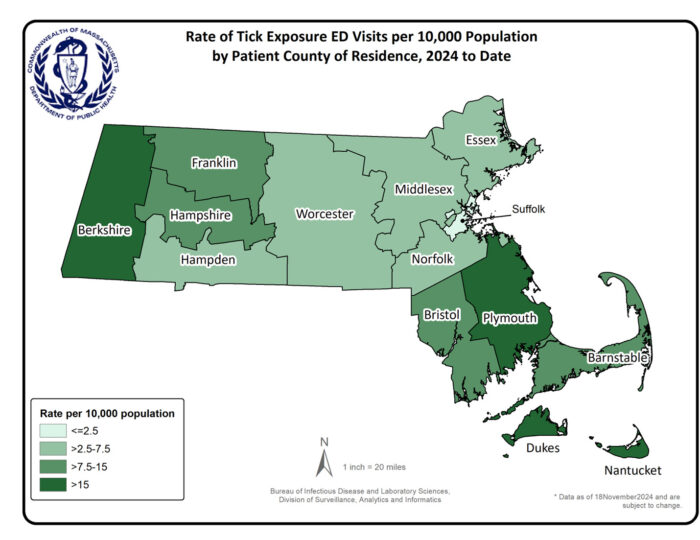
Ticks can carry a number of different diseases at one time, not just Lyme disease. Lyme disease (Ticks need to be attached to the skin for at least 24 hours to spread Lyme disease.), Babesiosis, Anaplasmosis are fairly common. Borrelia miyamotoi, and Powassan virus are more rare disease spread by the black-legged tick. Tularemia and Rocky Mountain spotted fever are rare disease spread by dog ticks. Ehrlichiosis is a bacterial disease spread by the lone star tick, which has only been found in southeastern Massachusetts.
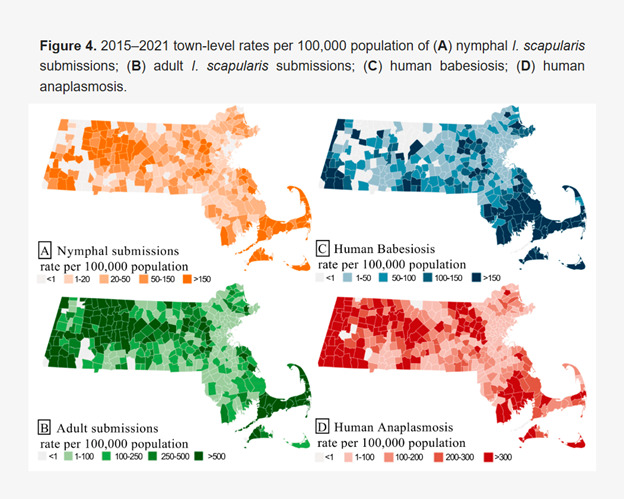
Siegel, E. L., Lavoie, N., Xu, G., Brown, C. M., Ledizet, M., & Rich, S. M. (2023). Human-Biting Ixodes scapularis Submissions to a Crowd-Funded Tick Testing Program Correlate with the Incidence of Rare Tick-Borne Disease: A Seven-Year Retrospective Study of Anaplasmosis and Babesiosis in Massachusetts. Microorganisms, 11(6), 1418. https://doi.org/10.3390/microorganisms11061418
Diseases
Trees require moist, well-drained soils in order to thrive. Conditions often found in residential landscapes such as restricted root zones, soil compaction, sandy soils and competition from surrounding trees and turfgrasses, drought or even over watering contribute to decline.
Beech Leaf Disease: Beech leaf disease (BLD) is an important disease of European and American beech trees. In just four years the disease has spread across the whole state. The map shows how much the disease has spread in the last few years. Unlike most other plant diseases that are caused by fungi, BLD is caused by a leaf infecting nematode (a microscopic round worm). Early signs of infection can be identified by dark banding between the leaf veins when looking up at backlit leaves. There are treatments that may help manage this disease and keep old established beech trees healthy for longer. Infection for only a few years may be enough to kill some trees. This disease only adds to the more common Phytophthora bleeding cankers, and beech bark disease causing decline in beech trees. It is worthwhile to begin treatment even with seemingly healthy trees to help reduce infection.
If you have seen any symptoms on your trees and shrubs that you think are not normal, let us know. We would be happy to help identify the problem and recommend solutions to help manage your plants.
